
| Camino de Santiago (Portomarin to Santiago) |
The Galician sky was still covered with cloud when we woke up, but for the first time in a while it hadn't rained during the night - things were looking up and we could set off, without the encumbrance of wet weather gear, to cross the small footbridge that spanned a reach of the Belesar Reservoir. We stopped briefly to admire its still reflections and headed out of town. The heavier packs were a small price to pay for the finer weather, especially on the steepish climb up through the woodlands out of Portomarin (we would have been saturated with perspiration had we worn rain gear). |
||
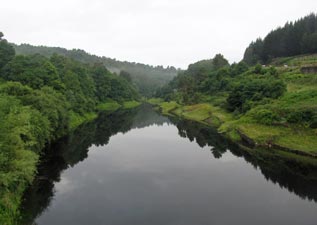 A still dark reach of the Belesar Reservoir |
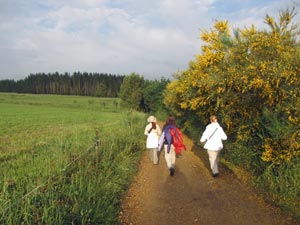 Ater four days - sunshine!!!! |
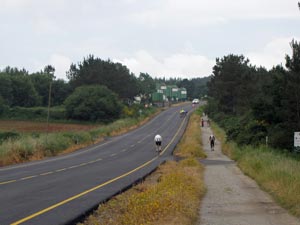 Section of camino parallelling the main road |
On the way up the fair Nello noticed something strange, something moving slowly ahead of us - it was a shadow! For the first time since we entered Galicia five days ago, the sun had appeared - spirits lifted, the woodland birds seemed to sing more loudly, the frogs in the trackside pondage croaked their approval and, to quote the refrain from an old song that came into my head, "the whole earth sang, the whole earth sang". Not even the long stretches of walking beside the roadways could dampen this sense of elation, as we passed a large brick factory with its piles of red clay, and pushed on into the sparkling Galician countryside. |
||
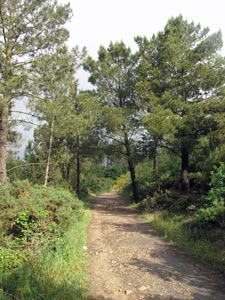 Track through the pines |
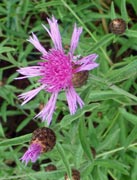 |
 |
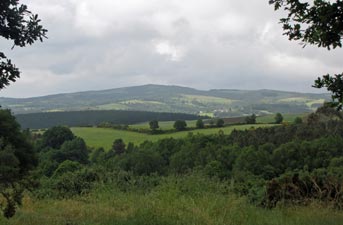 The green Galician countryside |
In fact the sun played cache-cache with the clouds as we pushed on, which never quite lost their menace and forced us unconsciously to quicken our pace. A quick refuelling stop of coffee and cake at Gonzar, and we continued the gentle climb along roadsides and occasional laneways, through Castromaior, Hospital and Ventas de Naron to the day's high point, crossing the 720m Sierra Ligonde. More and more, pine plantations were becoming part of the landscape. |
|||
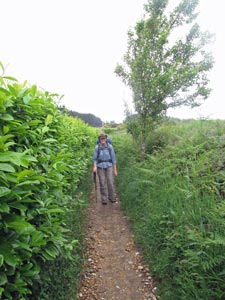 Hedgerow separating road from camino
|
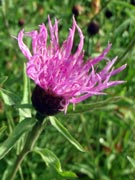 |
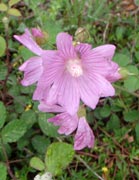 |
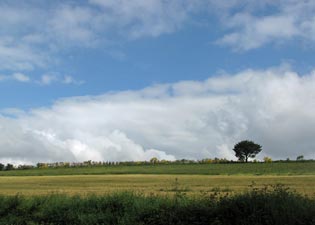 Celebrating the return of blue sky |
Dropping down to the village of Airexe, we declared a lunch break and, over a large bocadillo de jamon y queso, watched the continuing stream of pilgrims pass by. Since Sarria, the number of pilgrims had increased dramatically. It is the closest starting point on the camino from where you can obtain the compostela for completing the pilgrimage, and there were many of these "caminantes sarrianistos". They were easy to pick, carrying small day packs or none at all, support vehicles bringing them lunch or carrying their cases between stops. It was hard to resist a feeling of unpilgrim-like condescension. However, while we might be walking 500km, others were doing the whole 800+km of the Camino Frances, some like The Quebecois were walking all 1500km from Le Puy in France, and we had even heard the tale of one pilgrim who had walked 2500km from Gdansk in Poland. Each must choose his own path! |
|||
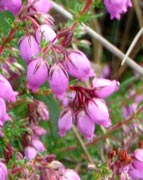 |
 |
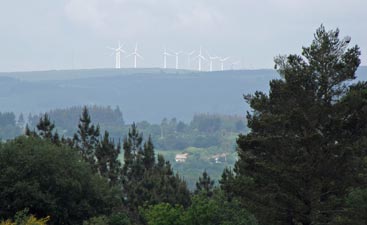 Homage to Don Quixote - view through the pines to distant wind turbines |
|
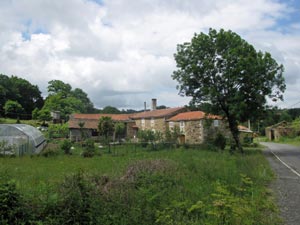 A change in building style to stone and red tile |
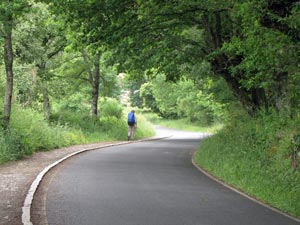 A pleasant section next to a quiet country road |
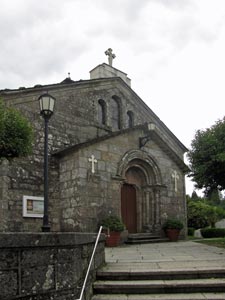 The Church of San Tirso, Palas de Rei |
Lunch over and values reassessed, we pushed on into the expanding sunshine, passing Porto, where we noticed for the first time that red tiles and light sandstone blocks had replaced the grey of slate as traditional building materials. Not long after Porto, a waft of nostalgic scent caught our attention - we were passing our first eucalyptus plantation. |
||
The unpredictable weather continued its variations and by the time that we wandered down into Palas de Rei, our shadows abandoned us to the grey clouds filling the sky. Still we had arrived dry for the first time in four nights, and checked in to the dormitorio of an albergue in the centre of town. We were back into sharing the pilgrim experience with others, whether they carried their own backpacks or not.
|
This morning the weather again offered us grey skies but no rain - we gladly accepted and headed out around 7.30am for our second longest distance on the the camino. Leaving the ultra white square of Palas de Rei, we followed road and laneway for 3.5 km to San Xulian, where we stopped at the local bar for breakfast. We were lucky, as the owner was just about to shut up for his Sunday off and took pity on a pair of hungry pilgrims. Re-energised, we pushed on to cross the narrow tree-lined Rio Pambre. It was the first of six stream crossings for the day, a day which apart from the climbs out of river valleys was generally leading us down. Climbing up from the Pambre, we followed a succession of laneways through mixed woodland and fields, through the hamlet of Mato-Casanova and pretty stone village of Leboreiro, with its 13th century romanesque chapel. |
||||
|
Dropping down, we crossed a small medieval bridge over the Rio Seco. Soon after, we reached one of the worst sections of camino, stuck between a busy national route and an large industrial park.
Our pace quickened, as much for the darkening sky and few drops of moisture as for the uninspiring surrounds, leading us back onto a densely forested laneway that took us down to the Rio Furelos and its picturesque four-arched medieval bridge. |
|
||
|
From the traditional stone-housed village of Furelos, we climbed up past the bland concrete apartment blocks of suburban Melide, to reach the centre of this town. It was alive with people at the morning markets and out for Sunday strolls, so we found a cafe on a street corner and had an early lunch as the fair Nello engaged one of her favourite past-times - people-watching. Still, we were only half-way to our destination and pushed on, warmed by the presence of sunshine in the unpredictable Galician sky. A cool wind seemed to be blowing the clouds away. |
 Track through a grove of eucalypts |
 |
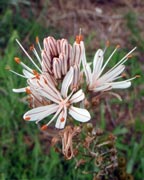 |
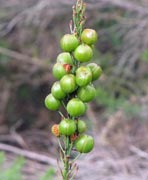 |
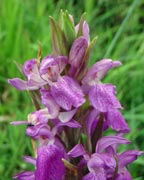 |
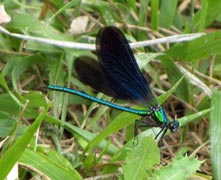 |
Descending out of Melide, we wound our way down the laneways and country roads, past farm and field to cross the Arroyo San Lazaro on a series of stepping stones. Here we found ourselves in a curious mixed oak-eucalyptus woodland (had the eucs gone feral or were the oaks recolonising the euc plantations?). The amount of eucalyptus and pine plantation was definitely increasing in this region, but they all provided beautiful timbered walkways and a shade better appreciated on hot summer days. |
|||
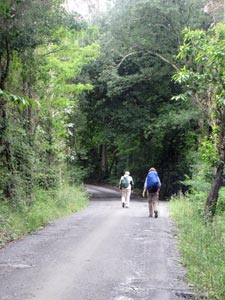 |
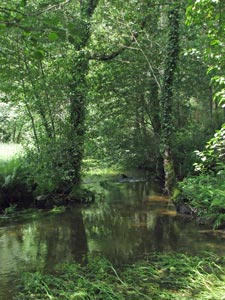 The peaceful setting of the Arroyo San Lazaro |
 Stone ford across the San Lazaro |
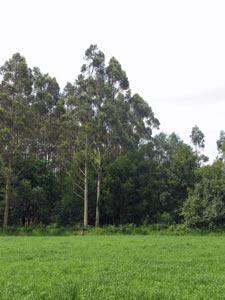 Eucalyptus becoming more common |
|
|
|
|
Emerging form the woodland, we reached the village of Boente, stopping for a snack in the quiet square, before descending steeply to cross the Rio Boente in its forested valley. The ascent out of the valley was as steep and even longer, requiring us to get into a regular rhythm to push on to pass through Castañeda and up to the ridge overlooking distant Arzua. |
|||
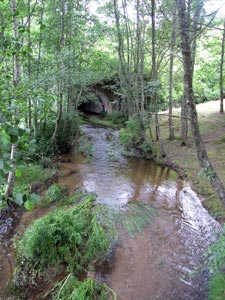 The Rio Boente |
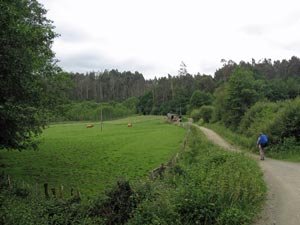 The road to Castañeda
|
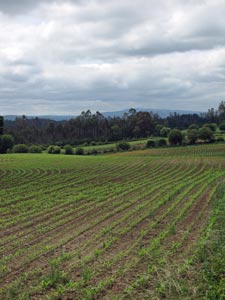 Newly sown field near Castañeda |
| Firstly though, we were obliged to descend for our last stream crossing, the Rio Iso at Ribadiso, site of a medieval pilgrim hostel that has been restored into a new pilgrim hostel. We stopped for a cold drink and spell, but did not stay. Our goal was Arzua, one last climb away. |
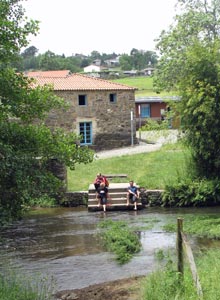 Pilgrims cooling their feet in the Rio Iso |
||
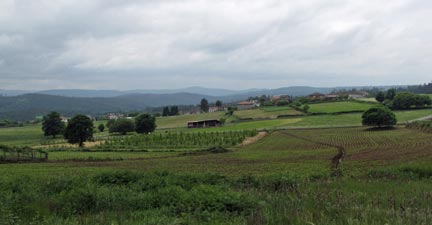 Rural countryside east of Ribadiso |
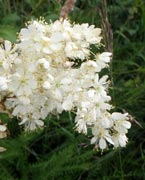 |
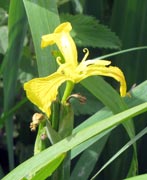 |
|
Having settled in to our 42-bed dormitory at the albergue and enjoyed a cold beer as reward for our long day, we set out to look for a place to eat. Spoiled by the wide choice of pilgrim menus at various restaurants in every other place we have stayed, we and a lost-looking crowd of fellow pilgrims were thrown by the general absence of open eating places on a Sunday evening in Arzua. Luckily, our albergue had one of the few bars open and offering food, so we retreated there to a large bowl of pasta and an early night. After this long section of the camino, that was something that we both needed.
|
|||
A slow improvement in the weather - cloudy with the odd patches of sunshine and a cool wind greeted us as we headed westward out of Arzua, fording the narrow Rio As Barrosas and on our way towards Santiago. The goal was closer and the number of peregrinos seemed even more. For a while we were caught up with a group of "peregringos" - American teenagers, typically somewhat loud but very friendly. We chatted for a while with one of the teachers accompanying them - she gave us a handmade felt camino pouch as a parting gift - thanks Lyn, your kindness will be remembered. In fact, we have noticed quite a difference in make up of pilgrims in this last section - many more North Americans than in France, still a lot of French (but of course this is the Camino Frances), Germans and Italians, but the great majority were Spanish, absent north of the border, but not surprisingly abundant in their homeland. The camaraderie still existed, but was not as great as in our first two sections, perhaps partly due to a language barrier, perhaps partly due to a noticable rush to the finish. |
|
|
|
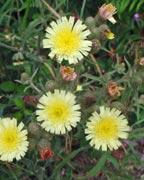 |
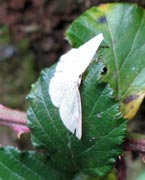 |
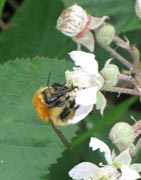 |
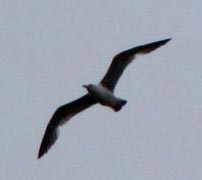 |
The other thing we noticed was a growing lethargy, again perhaps because we were nearing the end, but also because there was a certain sameness of landscape over the past couple of days. Pretty as it was, the flow of country road and laneway, forest, field and fallow, hamlet and village was beginning to blur in the memory. There were no attention-grabbing vistas or sights to define the passing of our footsteps. We strolled on through this landscape to stop off for our now traditional morning coffee at a roadside bar in Calzada, moving on through the ever increasing plantations of pine and eucalyptus to the village of Calle. |
||||
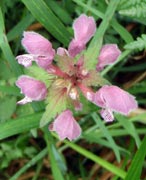 |
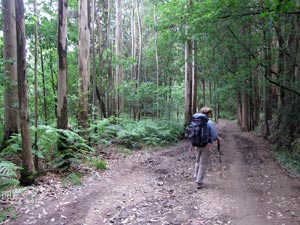 In a curious mixed eucalyptus-oak woodland |
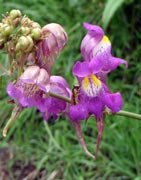 |
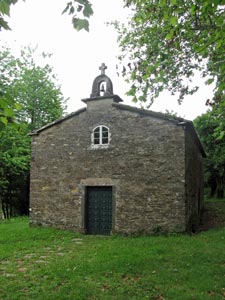 The chapel at Santa Irene |
After wandering down its narrow laneways, we once again crossed the Galician countryside to Salceda, where a bit of walking next to the busy Ruta N547, taking road traffic into and out of Santiago, brought us noisily back into focus. Just after Salceda, we passed a memorial to a pilgrim who had died on the track, one day short of his goal - another reality check. |
|||
On again by roadside, country lane and tiny hamlet to O Emplame for lunch at a busy roadside cafe. A final wander through the dense and freshly-scented eucalypt plantations, passing by the pretty 18th century chapel of Santa Irene, brought us to Arco O Pino, our last stop before Santiago. We found our pleasant and very modern albergue there - big glass windows overlooking the green pastures and trees beyond. |
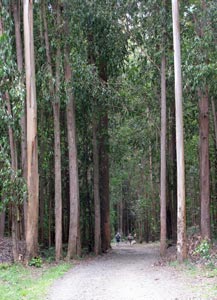 The eucalypts grow tall and straight in Spain |
|
|
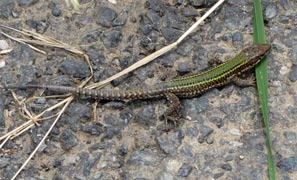 |
|
It was a good place to spend the afternoon, preparing for the last walk into Santiago. A pilgrimage has such an intense focus on its destination that the risk lies in forgetting the journey - hopefully we could find the balance. That depended in no small part in understanding why we were actually doing the walk, something that, in the past 22 days, has never leapt out with resounding clarity.
|
After a night in perhaps the best albergue that we had stayed in and after eating the best pilgrim menu of the trip, we left Arca O Pino feeling good. However, the camino had a couple of surprises still up its sleeve - a final shower, just enough to make us put on poncho and pack cover, and a track detour that forced us out of the aromatic eucalypt plantation and alongside the noisy, fuel-fumed highway for a distance. Just a reminder not to get too cocky. |
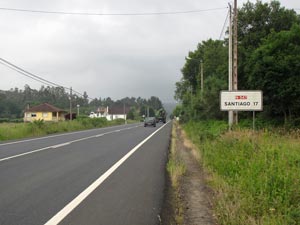 With only 17km to go, the direct route lay next to the main road ..... |
 .... it was more peaceful meandering through the eucalypts |
|
|
From then on it was a steady procession through forest and scrub, to pass beneath the end of the runway of Labacolla Airport and the busy autostrada - civilisation was returning with a vengeance as we neared the city of Santiago. A final morning coffee, and we headed off for our last push into town, winding through the backroads of Labacolla village, before commencing the climb up to Monte del Gozo. It was the last chance to walk in the peace of the Spanish countryside, and we were hurried up the long and steady climb by a stiff tailwind that rushed through the canopy of eucalypt, pine or oak. |
|||
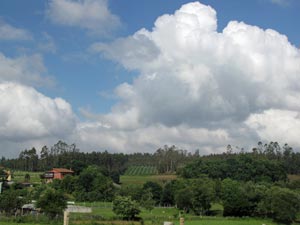 Cumulus over Labacolla |
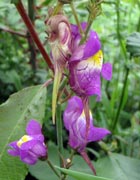 |
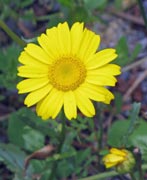 |
|
Reaching the high point and the pretty little Chapel of San Marcos, we could now look over the broad spread of Santiago. Without fanfare we started the descent through suburbia into the city. For some strange reason, I had conjured up an image of pilgrims massing at this stage to enter the city in joyful crowd - not so, just a steady dribble of ones, twos and small groups. |
|||
|
It was a somewhat low key entry, crossing autostrada, railway and wandering down busy roads. In fact, we decided to stop off at our somewhat new age albergue, drop our packs and clean up before heading off on the last kilometre. Thus, light-footed and feeling decidely unpilgrim-like without our packs, we entered the old city centre. My emotions on arriving were somewhat unexpected - a sense of achievement was there but the point still eluded me. 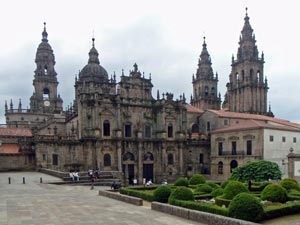 The 12th century Cathedral de Santiago de Compostela |
|
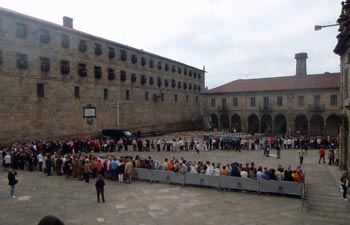 Queue waiting to visit the crypt of St James |
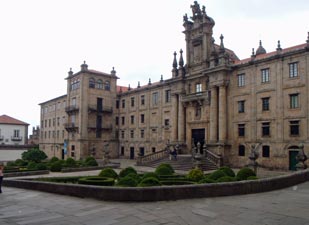 The monastery of San Martiño Pinario |
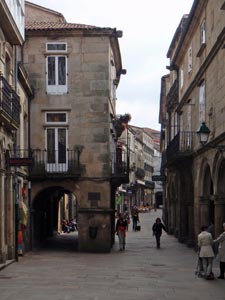 The streets of old Santiago |
Arriving in the huge Praza Obradoiro, dominated by the massive and ornate western face of the Cathedral de Santiago, our long walk was effectively over, apart from a few time-honoured pilgrim traditions - visiting the cathedral itself to pass by the Portico de Gloria and see where pilgrims over the centuries had worn finger-holes into the 12th century carved marble columns (no touching any more!). |
||
From here the traditional path led us to join the queues to pass behind the altar to hug the gilded statue of the Apostle James (sorry, St James, I just couldn't do it and the fair Nello prefers trees to statues) and then visit the crypt beneath, where a silver reliquary contains his remains. Standing in front of the silver casket, in its simple stone vault, with thousands of people milling about the magnificent edifice built around this relic, and the millions having come here over the centuries hoping to be rewarded for this act of devotion to St James, I thought I heard a still sad voice whisper "what in heaven's name have you turned me into?" ...... it was just the fair Nello telling me to get a move on because I was holding up the queue. |
|||
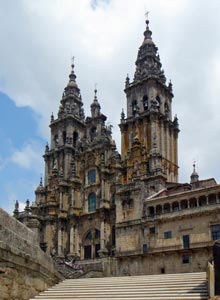 Face of the cathedral from the steps to the Praza Obradoiro |
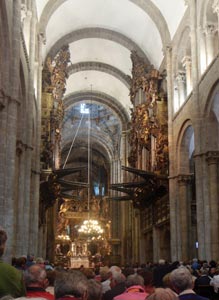 Interior of the cathedral |
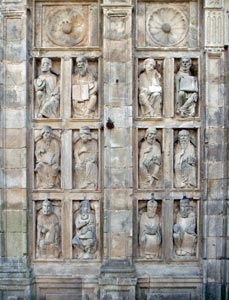 A section of wall-carving on the cathedral |
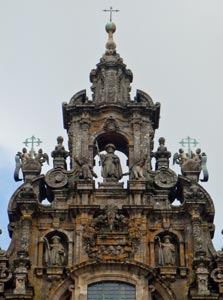 St James surveys the world from the central tower of the cathedral |
|
My sense of sadness was completed when, on leaving the crypt, I passed a sign offering extra indulgences for coming to Santiago in this special holy year of 2010 - for the living or the dead (plus an extra 10% discount at the airport duty free shop if you were flying home). How could such a simple message from 2000 years ago have become so distorted? How does symbolism become reality? Was I just experiencing a rush of anticlimactic cynicism? We wandered around to the pilgrim office to collect our compostelas (our own bit of symbolism for this walk), and sat in the Praza de Quintana de Vivos, slowly sipping a cold beer to celebrate and try to make some sense of it all. Meanwhile, the long queues to hug St James and visit the relics continued to snake by in the place below. |
|
It was at the packed pilgrim mass, as we watched the botafumiero swinging widely across dispensing its incense, as it has done for several centuries of pilgrim masses before, that I realised you need to be a very devout and traditional Catholic, for the destination to have importance in the sense it was originally intended. For the fair Nello and I, and I suspect the vast majority of modern-day pilgrims, this has really been about the journey and that is a very individual experience. In that sense, most of our walks have been a pilgrimage of sorts - walking to Santiago may provide focus but is not essential for the spiritual experience. Perhaps the lesson is that, in life, you make your own camino. And so, with that 20 cents worth of philosophy, to all the pilgrims, pilger, pelerins, peregrinos, peregringos and just plain walkers with whom we have shared this journey, as you head out on the paths that your life will follow - "BUEN CAMINO!!"
|
A short stroll to the End of the Earth (8.5 km - 290m ascent - 290m descent) |
Finisterre - in all ways, bar geography, the end of the earth for the ancient peoples of Europe. A long finger of land stretching into the Atlantic Ocean, where the people would gaze out toward the blue on blue horizon and wonder what lay beyond, darkness and monsters for the most part! Some pilgrims, ancient and modern continue on from Santiago for another 4 days to finish their journey at this mystical spot. We didn't have that time to spare, but we had managed to reclaim one free day over our walk - what better use to make of it than a day trip to the end of the earth. |
Thus we arrived by bus at Finisterre late in the morning, after a long trip stopping at the many small fishing and holiday villages that dot the deeply indented Galician coast line - La Costa de Morte - where over the centuries many fishermen have lost their lives in the wild Atlantic storms. Today, a strong and cool north-easterly blew but the sun shone brightly. It was a good day to be at the seaside. |
|
|
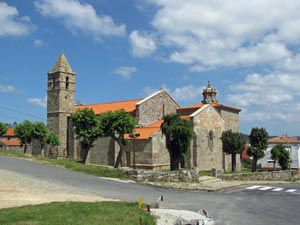 12th century Church of Santa Maria de Areas - Fisterra |
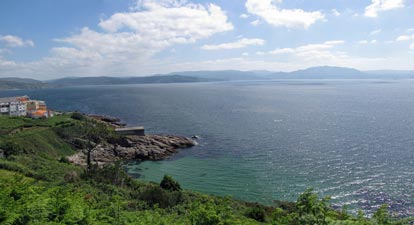 The clear blue sea of Finisterre |
|
Our last walk in Spain was short but spectacular. Leaving the village, we wandered up the road toward the cape, passing the beautifully restored 12th century Chapel of Santa Maria de Areas. Not long after, we turned off onto a gravel road that climbed up through the pines to the gorse-covered and windswept heights of Monte San Guillermo, the high point of the cape. |
|
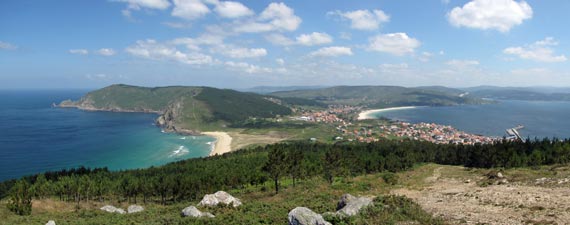 View from Monte San Guillermo eastward over the isthmus and Fisterra |
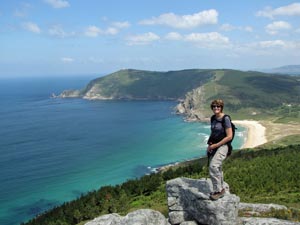 The fair Nello in front of Cabo de Naves |
|
Panoramic views lay in almost every direction. To the north, the rugged promontory of Cabo de Naves, not as charismatic as Finisterre, but geographically the most westerly point of continental Europe. To the east, the colourful village of Fisterra lay on a narrow neck of land, windmill-lined hills to its rear and a rugged coastline, dotted with white sand beaches, sweeping away to the south. |
||
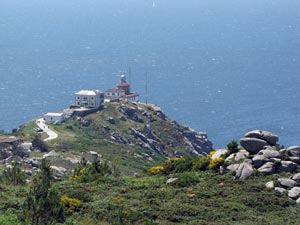 Looking down on the lighthouse at Cape Finisterre |
 The rugged coastline of the cape |
||
To the west, the sky and sea blurred hazily together beyond the rugged shore of Cabo Fisterra. We sat in the lee of the wind and looked out from the end of the earth to the endless blue beyond. The only direction without a view was south towards the tip of the cape, so we headed on to reach the end of the ridge and look down at the lighthouse of Finisterre. After the cathedral at Santiago, this is the next most visited place in Galicia. |
|||
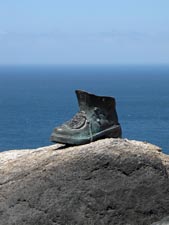 The boot at the end of the earth |
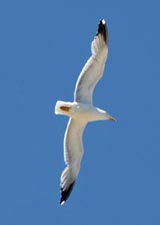 |
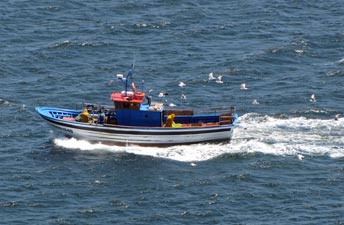 Fishing boat returning to port |
|
It was a short stroll down to the lighthouse and on to the rocks beyond. Here, with nowhere further west to walk in Europe, we had reached the end of our journey through northern Spain. The odd blackened rocks testified to the fact that some pilgrims still kept the ritual of burning their clothes (or perhaps a symbolic pair of undies) to mark the end of their camino. |
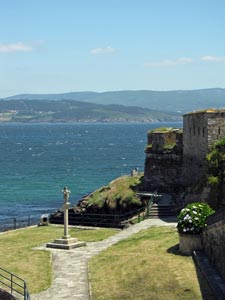 Castillo de San Carlos guarding the port of Fisterra |
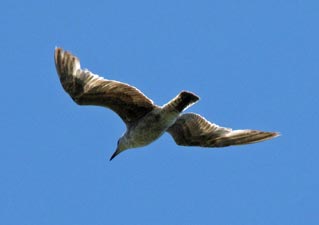 |
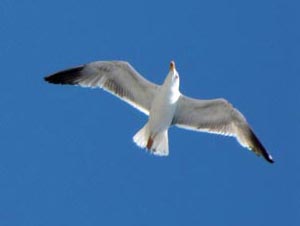 |
Following the road back, we dropped down to wander past the old fort and on to the fishing port, with its outdoor restaurants. Here we stopped off for a late celebratory lunch of freshly caught seafood and a chilled Galician white wine, in sunshine cooled by the ocean breeze and accompanied by the Atlantic gulls wheeling in the sky above. Today was a good way to end a very special journey - BUEN CAMINO!! |
||
|
||